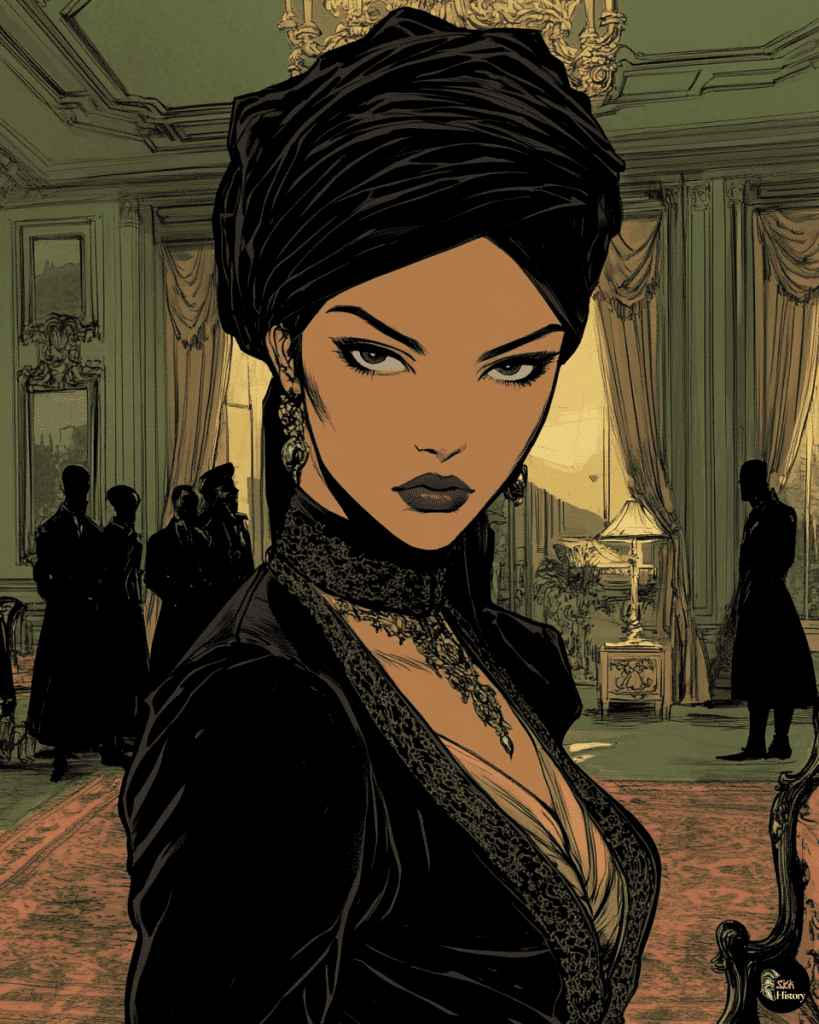In 1817, a mysterious young woman appeared in the village of Almondsbury near Bristol, England. She spoke an unknown language and wore exotic clothing, including a black turban.
The locals were captivated by her strange appearance and mannerisms.
The woman was taken in by the Worrall family, local gentry who believed her to be a foreign princess. She called herself Princess Caraboo from the island of Javasu.
For several weeks, Princess Caraboo charmed Bristol society with her unusual customs, peculiar language, and graceful gestures.
The true identity of Princess Caraboo was eventually revealed to be Mary Willcocks, a cobbler’s daughter from Devon. This clever hoax captivated the public’s imagination and has since inspired books, films, and continued fascination with the young woman who briefly fooled an entire town into believing she was exotic royalty.
The Princess Caraboo Affair
On April 3, 1817, a young woman in unusual attire appeared in Almondsbury, a small town near Bristol. She spoke an unknown language and communicated through gestures.
The woman wore a black shawl twisted turban-style around her head. Her exotic appearance and mysterious demeanor quickly caught the attention of local residents.
Unable to understand her, the villagers took her to the local magistrate. This encounter marked the beginning of the Princess Caraboo affair.
Identity of Mary Willcocks and Mary Baker
The woman who became known as Princess Caraboo was Mary Baker, born Mary Willcocks in Witheridge, Devon. She was the daughter of a cobbler, not the exotic royal she claimed to be.
Mary possessed a talent for deception and a vivid imagination. She crafted an elaborate backstory, claiming to be from a distant island called Javasu.
Her ability to maintain this facade for months demonstrated her intelligence and creativity. Mary’s motivations for the hoax remain a subject of debate among historians.
Roles of Mr. and Mrs. Worrall
Samuel Worrall, a local magistrate, and his wife Elizabeth played crucial roles in the Princess Caraboo story. The Worralls took the mysterious woman into their home, believing her to be royalty.
Mrs. Worrall, in particular, became fascinated by their guest. She provided Princess Caraboo with fine clothes and accommodations, befitting her supposed status.
The Worralls’ involvement lent credibility to the hoax. Their social standing in the community helped spread the story of the exotic princess throughout Bristol and beyond.
Unraveling the Mystery
In 1817, the Princess Caraboo affair captivated Bristol and surrounding areas. Various individuals played crucial roles in uncovering the truth behind the mysterious woman’s identity and origins.
Investigations by Mr. Gutch and the Overseer
Mr. Gutch, a local magistrate, took a keen interest in the case of Princess Caraboo. He conducted thorough inquiries into her background and linguistic abilities.
The parish overseer also contributed to the investigation, gathering information from locals who had interacted with the supposed princess.
Their efforts led to the discovery of inconsistencies in Caraboo’s story. Witnesses came forward with accounts contradicting her claims of royal heritage and exotic origins.
Javasu and the Exotic Turban
Princess Caraboo claimed to hail from Javasu, a fictitious island in the Indian Ocean. Her exotic appearance, enhanced by a black shawl twisted into a turban, lent credibility to her story.
The turban became a symbol of her supposed foreign identity. It played a significant role in convincing the Worralls and others of her royal status.
Experts in geography and foreign cultures were consulted to verify Javasu’s existence. Their findings cast doubt on Caraboo’s narrative.
The Portuguese Connection and the Devon Origins
As investigations progressed, a Portuguese sailor reportedly recognized Caraboo. This led to the revelation that she could speak some Portuguese, contradicting her claim of speaking an unknown language.
Further inquiries traced her origins to Devon, England. It was discovered that Princess Caraboo was actually Mary Baker, born Mary Willcocks, a cobbler’s daughter from Witheridge.
This revelation shattered the illusion of her exotic royal identity.
Public Reaction and the True Story’s Impact
The unmasking of Princess Caraboo as Mary Baker caused a sensation in Bristol and beyond. Many who her story had fooled felt embarrassed and betrayed.
Some, however, admired her ingenuity and acting skills.
The affair sparked debates about class, identity, and the nature of truth in society.
The story of Princess Caraboo became a cautionary tale about the dangers of accepting extraordinary claims without proper verification. It inspired numerous retellings, including books, plays, and a 1994 film starring Phoebe Cates.

